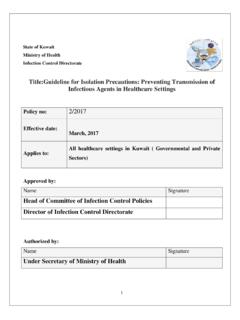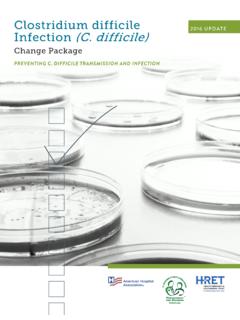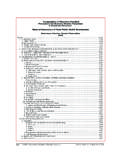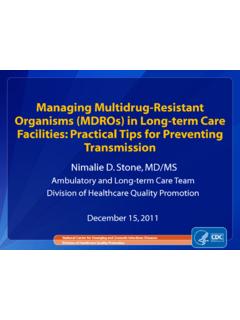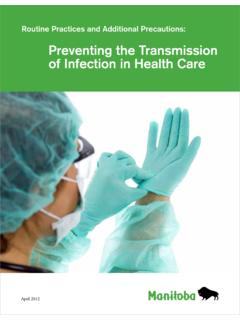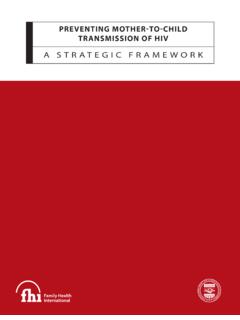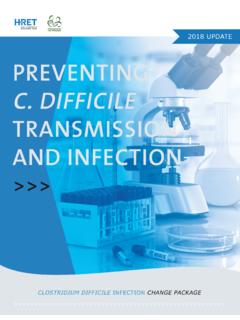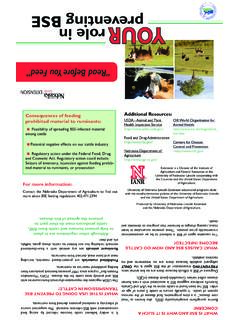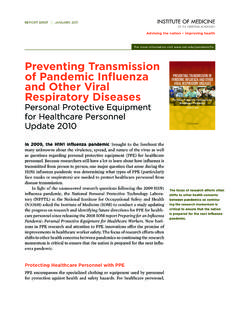Transcription of PREVENTING TRANSMISSION OF TUBERCULOSIS IN …
1 1 PREVENTING TRANSMISSION OFTUBERCULOSIS IN health CARE FACILITIES:AN ENGINEERING APPROACHABSTRACTIn recent years, the TRANSMISSION of TUBERCULOSIS in health care facilities (nosocomial TRANSMISSION )has reached epidemic proportions. These transmissions have included outbreaks of multidrug-resistantstrains of Mycobacterium TUBERCULOSIS that have produced many deaths. PREVENTING TRANSMISSION of TBin health care facilities requires a comprehensive program including effective identification, isolation,and treatment of infected persons, specific ventilation, general ventilation, personal respiratoryprotection and surveillance of health care workers. Epidemiology, TRANSMISSION and pathogenesis ofTB are discussed to provide a framework for understanding the disease. The engineering aspects ofhospital facility design related to controlling TB are outlined including general and specific ventilation,air filtration, ultraviolet germicidal irradiation, isolation suite design and room pressure controlstrategies.
2 For engineers and other professionals not directly related to the medical profession,definitions are included as an appendix to familiarize the reader with the terminology found in theextensive , the White Plague or Consumption was almost unheard of in the United States for overthirty years. Although TB was responsible for as many as one third of the deaths of citizensbetween the ages of 25 and 45 at the turn of the century, steady declines in the number of reported casesof the disease between 1953 and 1964 has led many to believe that this disease had been eradicated fromthe Indeed, many young people these days have not even heard of TB and the memory of TBsanitariums remains a distant memory to those in the baby boomer generation. Globally, TB still has ahigher mortality rate than any other single infectious disease and is responsible for approximately 3million deaths per In developing nations, 26% of avoidable adult deaths are attributed to , even in the , reported cases of TB are on the rise for the first time in a generation.
3 Morealarmingly, the percentage of multidrug-resistant strains of the disease is also prevention and treatment practices are being relearned, and new practices, techniques andtechnologies are being brought to bear against this disease. The engineering community is playing anincreasingly important role in the fight against the spread of TB, especially in health care facilities. Thispaper is intended as an overview of the disease and the engineering practices and technology requiredfor control of it. The references and bibliography contain many citations worthy of study by thoseintending to engage this HOW BAD IS THE SITUATION?The following quotes from medical and scientific journals reveal that TB, and especially multidrug-resistant TB, is a clear and present danger in health care facilities, especially to susceptible patients andhealth care workers.
4 "A 1992 study found that 10% of patients in a large hospital's HIV unit had TB, and that halfhad acquired the infection since admission. More than half the nurses working on the same floorhad a positive tuberculin test, indicating they were infected with the bacterium. The study alsofound inadequate air flow in the unit, which would spread the bacterium to other these outbreaks have involved multidrug-resistant strains of TB with extremely highmortality" (emphasis mine).4"In May 1989, all 17 [ health Care Workers] who worked in the HIV unit [of a large publicteaching hospital in San Juan, Puerto Rico], who by verbal history had a negative purifiedprotein derivative (PPD) tuberculin skin test at the time of employment, reportedly testedpositive. This finding suggested that TB TRANSMISSION was occurring at the hospital (emphasismine).
5 5"The CDC found up to 15% of TB cases resistant to at least one antituberculous drug. Up to4% of cases may be resistant to isoniazid and rifampin, the top two choices in treating TB."6"One-third of all cases tested in a New York City survey in 1991 were resistant to one ormore drugs. The case fatality rate for TB resistant to two or more major antibiotics (multidrugresistance) is 40 to 60%, equivalent to untreated TB (emphasis mine).7TB: AN OVERVIEWWhat is TB?TB is bacterial infection caused by rodlike organisms called Mycobacterium TUBERCULOSIS ,Mycobacterium bovis, and Mycobacterium africanum, also called tubercle bacilli. It is most often foundin the lungs, although the bones and other organs may also be is at risk of TB infection?Certain groups of people are more likely to contract TB than others due to demographics or otherfactors.
6 These include HIV infected individuals, health care workers, persons living in the samehouseholds or in frequent contact with TB infected individuals or individuals from certain demographicgroups that have a high incidence of TB. These groups include Blacks, Asians, Pacific islanders, nativeAmericans, Alaskan natives, Hispanics, current or past prison inmates, alcoholics, intravenous (IV) drug4users, the elderly, and foreign born persons from areas of the world with a high prevalence of TB ( ,Asia, Africa, the Caribbean, and Latin America).8,9 Who is at risk of progression from a latent TB infection to active TB?Like above, certain groups of people are more likely to progress to an active TB infection from alatent condition once the disease is contracted. These include individuals with the following conditions:HIV infection, silicosis, status post gastrectomy or jejuno-ileal bypass surgery, being more than 10pounds below ideal body weight, chronic renal failure, diabetes mellitus, immunosuppression due toreceipt of high-dose corticosteroid or other immunosuppressive therapy, some malignancies, recentinfection with TB (in the last two years), fibrotic lesions on chest radiograph, and children under the ageof 5 ,9TB TRANSMISSION :TB is transmitted via the air through inhalation.
7 Mycobacterium TUBERCULOSIS is carried in airborneparticles known as droplet nuclei that can be generated when persons with pulmonary or laryngealtuberculosis sneeze, cough, speak, spit, or sing. Droplet nuclei may also be generated by medicalprocedures such as respiratory therapy (AP), bronchoscopy, endotracheal intubation, open abscessirrigation, and autopsy. The droplet nuclei are so small (1-5 m) that they can be suspended indefinitelyin the air and be spread throughout a facility by the HVAC system. The probability that a susceptibleperson will become infected with Mycobacterium TUBERCULOSIS depends primarily upon the concentrationof infectious droplet nuclei in the air and the exposure duration. Unlike other airborne diseases (such asLegionella pneumophilla) which require large aerosolized colonies of bacteria to produce an infection,TB exposure has no TLV.
8 It has been demonstrated that one TB bacillus is enough to infect ,9 Environmental factors that enhance the likelihood of TB TRANSMISSION :There are three major environmental factors that can facilitate TB TRANSMISSION . The first isexposure of susceptible persons to an infectious person in relatively small enclosed spaces like hospitalpatient or treatment rooms. The second is inadequate local or general ventilation that results in5insufficient dilution and/or removal of infectious droplet nuclei. The third is recirculation of aircontaining infectious droplet nuclei without adequate filtration or disinfection. Eliminate these, and therisk of TRANSMISSION of TB is significantly ,9 METHODS OF INFECTION CONTROLThe Centers for Disease Control acknowledge four major methods of TB infection identification, isolation and treatment of persons with active TB.
9 This is the foundation ofall infection control programs. Isolation and treatment are impossible without proper (and early)identification of those Controls: These are the engineering methods, systems, and equipment required toaccomplish the isolation mentioned above and usually involve the following five areas: source control(during procedures that can produce large quantities of droplet nuclei, , sputum induction chambers);directional airflow to provide continuous flow from the cleaner to the dirtier parts of the facility; roompressure controls to prevent contamination of areas adjacent to infection sources; general ventilation todilute and remove contaminated air; air cleaning via HEPA filtration; and ultraviolet germicidalirradiation (UVGI).9 All these will be covered in more detail to respirators: These are special valveless filtered face masks which prevent the passage ofparticles larger than one m.
10 They are required by OSHA, under certain circumstances, to protect healthcare workers exposed to patients with active TB during high-risk medical procedures such as sputuminduction. They may also be used for "isolation" of TB patients during intra- and inter-facility transportwhen outside infectious isolation facilities or when they are ,10 Surveillance of health care workers for TB infection. This is a necessary part of all TB infectioncontrol programs. It can indicate the spread of infection throughout a facility and indicate closersurveillance of workers who have positive TB CONTROLThe use of local exhaust ventilation to remove airborne contaminants at or near their source is aneffective infection control measure and should be used whenever possible. There are four types ofsource control ventilation devices that are commonly used.
